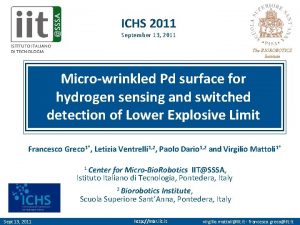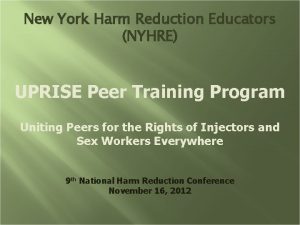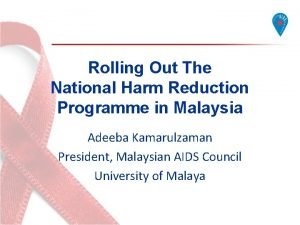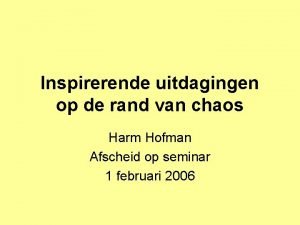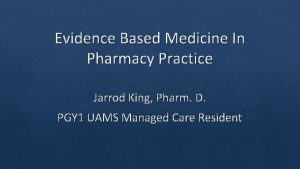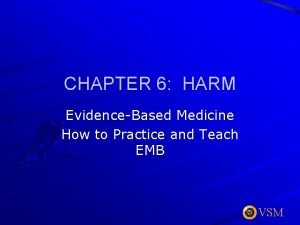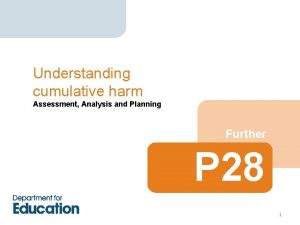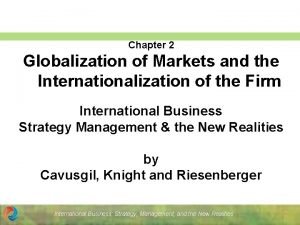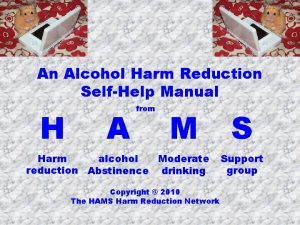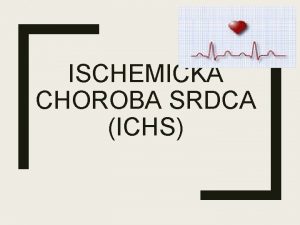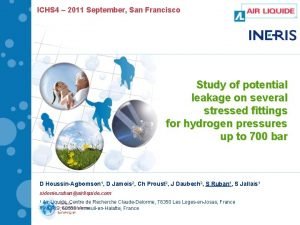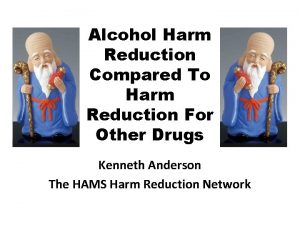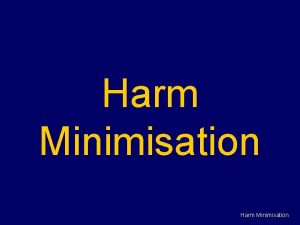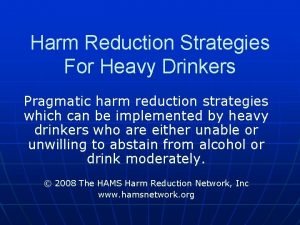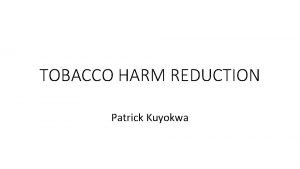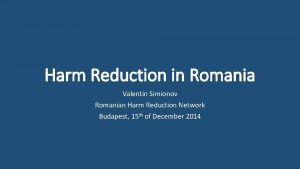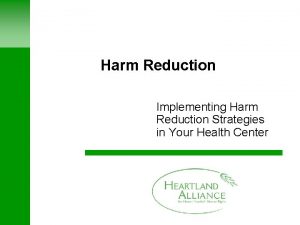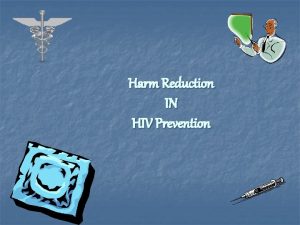Presentation for ICHS 2011 Study on the Harm



















- Slides: 19

Presentation for ICHS 2011 Study on the Harm Effect of Liquid Hydrogen Release by Consequence Modeling Institute for Hydrogen Energy Technologies Presented by: Dr. LI. Zhiyong Instructed by: Prof. MA. Jianxin Dr. PAN. Xiangmin September 14 th, 2011 TONGJI UNIVERSITY Institute for Hydrogen Energy 1

Introduction of IHET in Tongji University IHET (Institute for Hydrogen Energy Technologies) has been focused on hydrogen infrastructure R&D in China for more than 10 years. Ø Engineering practice on hydrogen technologies Four hydrogen refueling stations (HRS); Several mobile HRS; A demo coking gas purification facility Ø Technical experience in building codes and standards Technical Code for Hydrogen Fuelling Station (GB 50516 -2010); Technical Specification of Hydrogen Refueling Stations for Fuel Cell Vehicles (DGJ 08 -2055 -2009) Ø Numerical research experience on hydrogen releases The potential hazards of accidental gaseous hydrogen release; The harm effect of different consequences such as jet fire, flash fire, physical explosion and vapor cloud explosion. TONGJI UNIVERSITY Institute for Hydrogen Energy 2

First HRS developed by IHET 2006, Shanghai Anting HRS, serving for FCVs test for 2008 Olympic Games TONGJI UNIVERSITY Institute for Hydrogen Energy 3

Hydrogen supply network developed by IHET 2010, Expo station, serving for FCVs for 2010 Expo Anting HRS By-product H 2 Purification Plant Mobile HRS EXPO HRS 100 FC Sight-seeing Cars TONGJI UNIVERSITY 6 FC Buses Institute for Hydrogen Energy 90 FC Cars 4

Hydrogen filling infrastructure built by IHET recently 2010, Guangzhou HRS, serving for the 2010 Asian Games 2011, Shengzhen HRS, serving for the 2011 World University Games TONGJI UNIVERSITY Institute for Hydrogen Energy 5

Contents 1. Introduction 1. 1 Background and objective of this study 1. 2 Potential hazard of liquid hydrogen storage 2. Modeling 2. 1. Possible consequences of liquid hydrogen release 2. 2 Harm criteria 2. 3 Model and assumptions 3. Results and discussions 3. 1 Harm effect distance of each consequence 3. 2 Comparison with compressed hydrogen vessel 4. Summary TONGJI UNIVERSITY Institute for Hydrogen Energy 6

1. Introduction 1. 1 Background and objective of this study Liquid hydrogen can be stored and transported in much larger quantities than compressed hydrogen and may be considered as an alternative storage for hydrogen vehicles. n This paper studies the accidental release of hydrogen from cryogenic liquid storage tank and calculates the subsequent consequences such as hydrogen cold cloud, fire ball, jet fire, flash fire, and vapor cloud explosion. n The purpose is to evaluate the harm distance of the cold effect, thermal effects and overpressure effects from above hydrogen consequences. TONGJI UNIVERSITY Institute for Hydrogen Energy 7

1. Introduction 1. 2 Potential hazard of liquid hydrogen storage The principle hazard associated with cryogenic storage is the accidental released hydrogen related to its low temperature and flammable potential. n For low temperature, the reduction in temperature by the released hydrogen may cause cryogenic burns to people. n For flammable effect, the primary hazard is related to fire and explosions. Ø In a fire event, the radiant heat fluxes or direct contact with hydrogen flames may cause burn to people. Ø In vapor cloud explosion event, the blast wave overpressures are harmful to people. TONGJI UNIVERSITY Institute for Hydrogen Energy 8

2. Modeling 2. 1 Possible consequences of liquid hydrogen release Without ignition Cold cloud Instantaneous release Liquid hydrogen Direct ignition Fireball Flash fire With ignition Delayed ignition Vapor cloud explosion Without ignition Cold cloud Continuous release Direct ignition With ignition Delayed ignition Figure 1 TONGJI UNIVERSITY Jet fire Flash fire Vapor cloud explosion Event tree of liquid hydrogen release Institute for Hydrogen Energy 9

2. Modeling 2. 2 Harm criteria Table 1 Harm criteria used in modeling Consequences Harm effect Harm criteria to people Cold cloud Cold effect -40℃[1] Fire ball Flame contact ; heat radiation Fireball radius; 9. 5 k. W/m 2[1] or 520 (k. W/m 2)3/4 s[2] Jet fire Flame contact; heat radiation Jet fame length; 9. 5 k. W/m 2 [1] or 520 (k. W/m 2)3/4 s[2] Flash fire Flame contact Lower flammable limit (4%)[1] Vapor cloud explosion Overpressures 0. 07 bar[1] IGC Doc 75/07/E/rev. Determination of Safety Distances. European Industrial Gases Association, 2007 [2]CPR 16 E (Green Book). A Model for the determination of possible damage. TNO, 1992 TONGJI UNIVERSITY Institute for Hydrogen Energy 10

2. Modeling 2. 3 Model and assumptions n The thermal effects including both direct flame contact and heat radiation from immediate ignition consequences are calculated with fireball model by Martinsen, et al [3] and jet fire model by Cook, et al [4], respectively. n The explosion overpressure of a vapor cloud explosion is calculated with a Baker-Strehlow method [5]. [3] Martinsen, et al. ,An improved model for the prediction of radiant heat from fireballs. International conference and workshop on modelling the consequences of accidental release of hazardous materials, San Francisco California, 1999 [4] Cook J, et al. A comprehensive program for calculation of flame radiation levels. Journal of Loss Prevention in Process Industries, 1990 [5] Baker, Q. A. et al, Recent Developments in the Baker-Strehlow VCE Analysis Methodology, the 31 st Loss Prevention Symposium, 1997 TONGJI UNIVERSITY Institute for Hydrogen Energy 11

2. Modeling 2. 3 Model and assumptions Table 2 Modeling assumptions and parameters Item Catastrophic rupture Leak from tank Release inventory (kg) 3. 5 Release pressure(bar) 1 Release direction —— Horizontal, downwind Release hole size (mm) —— Vary, up to 10 mm Release height (m) 1 Atmospheric temperature (℃) 15 Wind velocity (m/s) 5 Pasquill stability D (neutral) Result output height (m) 1 TONGJI UNIVERSITY Institute for Hydrogen Energy 12

3. Results and discussions 3. 1 Harm effect distance of each consequence Harm effect distances (m) Ø Vapor cloud explosion>flash fire>cold cloud>fireball Ø Harm effect from the heat radiation of the fireball may be neglected 45 40 35 30 25 -40℃ 20 15 10 5 0 Cold cloud 0. 07 bar 4% concentration 9. 5 k. W/m 2 520 (k. W/m 2)3/4 s Flame contact Not reached Fire ball Flash fire Vapor cloud explosion Figure 2 harm effect distances of catastrophic rupture of liquid hydrogen tank TONGJI UNIVERSITY Institute for Hydrogen Energy 13

3. Results and discussions 3. 1 Harm effect distance of each consequence Harm effect distances (m) Ø Vapor cloud explosion>jet fire>flash fire>cold cloud Ø Thermal dose of Jet fire> fireball for the reason of duration Ø Catastrophic rupture is the dominate event rather than leak scenarios 12 0. 07 bar 10 8 9. 5 k. W/m 2 520 (k. W/m 2)3/4 s Flame contact 4% concentration 6 4 2 0 -40℃ Cold cloud Flash fire Vapor cloud explosion Figure 3 harm effect distances of 10 mm leak from liquid hydrogen tank TONGJI UNIVERSITY Jet fire Institute for Hydrogen Energy 14

3. Results and discussions 3. 1 Harm effect distance of each consequence Harm effect distances (m) Ø Harm effect distances increases with the growth of leak diameter Ø Harm sequence do not change with leak diameters 12 Cold effect Flame contact of jet fire Thermal radiation intensity from jet fire Thermal dose from jet fire Flame contact of flash fire Overpressure from vapor cloud explosion 10 8 6 4 2 0 1 TONGJI UNIVERSITY 2 5 6 7 9 8 Release diameter (mm) Figure 4 harm effect distances for leak from liquid hydrogen tank with different release hole size 3 4 Institute for Hydrogen Energy 10 11 15

3. Results and discussions 3. 2 Comparison with 70 MPa storage Harm effect distances (m) Ø With ignition, liquid hydrogen storage may be more dangerous Ø Without ignition, liquid hydrogen storage may be safer Ø In total, liquid hydrogen storage may be more dangerous than 70 MPa storage in case of catastrophic rupture 45 40 35 30 25 20 15 10 5 0 Liquid hydrogen 70 MPa hydrogen storage Cold cloud Physical Fire explosion ball Flash fire Vapor cloud explosion Figure 5 harm effect distances of catastrophic rupture under different storages TONGJI UNIVERSITY Institute for Hydrogen Energy 16

3. Results and discussions 3. 2 Comparison with 70 MPa storage Harm effect distances (m) Ø With ignition, liquid hydrogen storage may be safer Ø Without ignition, liquid hydrogen storage may be a little more dangerous Ø In total, liquid hydrogen storage may be safer than 70 MPa storage in case of leak scenario 60 50 Liquid hydrogen 70 MPa storage 40 30 20 10 0 Cold cloud Flash fire Vapor cloud explosion Figure 6 harm effect distances of 10 mm leak under different storages TONGJI UNIVERSITY Jet fire Institute for Hydrogen Energy 17

4. Summary n For instantaneous releases of liquid hydrogen, the sequence of harm effect distances is that vapor cloud explosion>flash fire>cold cloud> fireball. n For continuous releases of liquid hydrogen, the sequence of harm effect distances is that vapor cloud explosion>jet fire>flash fire>cold cloud. n The liquid hydrogen storage may be safer than 70 MPa gaseous storage in case of leak scenario but may be more dangerous than 70 MPa storage in case of catastrophic rupture. It is difficult to tell which storage is safer from a consequence perspective. Further investigation need to be made from a standpoint of risk, which will combine both consequences and the likelihood of scenarios. TONGJI UNIVERSITY Institute for Hydrogen Energy 18

Thanks for Your Kind Attention Welcome Your Comments! TONGJI UNIVERSITY Institute for Hydrogen Energy 19
 Ichs
Ichs Ichs mkn
Ichs mkn Flyvbjerg case study 2011
Flyvbjerg case study 2011 Does advertising help or harm us
Does advertising help or harm us Harm reduction worksheets
Harm reduction worksheets New york harm reduction educators
New york harm reduction educators Number needed to harm formula
Number needed to harm formula Zero harm culture
Zero harm culture Node of ranvier channels
Node of ranvier channels Harm reduction programme
Harm reduction programme Harm hofman
Harm hofman How to calculate number needed to treat
How to calculate number needed to treat Number needed to harm
Number needed to harm Cumulative harm
Cumulative harm Joanna self harm
Joanna self harm Repeated systematic efforts to inflict harm
Repeated systematic efforts to inflict harm Being legally responsible for causing harm is
Being legally responsible for causing harm is Firm level consequences of market globalization
Firm level consequences of market globalization Where does beowulf see a tremendous sword
Where does beowulf see a tremendous sword Harm reduction worksheets
Harm reduction worksheets
